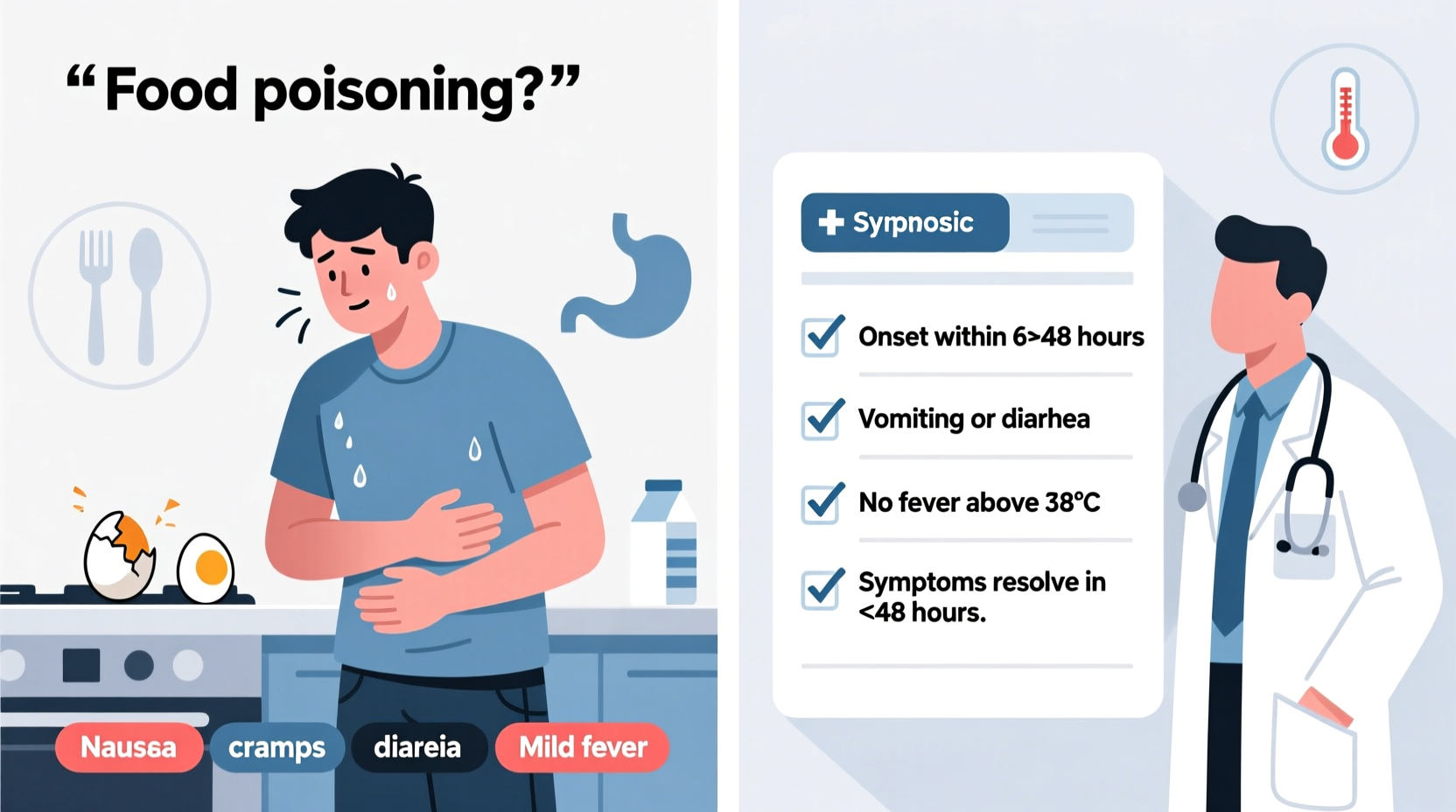How to Recognize Food Poisoning: Your Essential Symptom Guide
If you're wondering how to know if you have food poisoning, you need clear, actionable information fast. This guide delivers exactly what you need to identify foodborne illness, understand when symptoms require emergency care, and take appropriate action—based on CDC and medical authority guidelines.Your Food Poisoning Symptom Checklist
When determining how to tell if you have food poisoning, check for these common symptoms that typically appear 30 minutes to 72 hours after consuming contaminated food:- Nausea and persistent vomiting
- Watery or bloody diarrhea
- Abdominal cramps and pain
- Fever above 100.4°F (38°C)
- Headache and body aches
- Loss of appetite
- Weakness and fatigue

Timeline: When Symptoms Appear After Exposure
Understanding the food poisoning timeline helps distinguish it from other illnesses. Different pathogens have characteristic onset periods:| Pathogen Type | Onset Time | Duration |
|---|---|---|
| Staphylococcus aureus | 30 min - 8 hours | 1-2 days |
| Salmonella | 6-72 hours | 4-7 days |
| E. coli | 1-10 days | 5-10 days |
| Norovirus | 12-48 hours | 1-3 days |
| Listeria | 1-4 weeks | Variable |
Source: Centers for Disease Control and Prevention
Food Poisoning vs. Stomach Flu: Critical Differences
Many people confuse food poisoning symptoms vs stomach flu, but understanding the difference affects your treatment approach. This comparison helps you determine how to tell if you have food poisoning rather than viral gastroenteritis:- Onset speed: Food poisoning symptoms typically appear faster (within hours) compared to stomach flu (1-3 days)
- Symptom pattern: Food poisoning often affects multiple people who ate the same food
- Duration: Most food poisoning resolves in 1-3 days, while stomach flu may last longer
- Fever intensity: Food poisoning often causes higher fever than stomach flu
When to Seek Emergency Medical Care
Knowing when to go to hospital for food poisoning could save your life. Seek immediate medical attention if you experience any of these severe symptoms:- Diarrhea lasting more than 3 days
- Severe dehydration (dry mouth, dizziness, reduced urination)
- Bloody or black stools
- High fever (over 101.5°F or 38.6°C)
- Neurological symptoms like blurred vision or muscle weakness
- Signs of kidney failure (reduced urine output)
According to the FDA Food Safety guidelines, certain populations require immediate medical evaluation: infants, elderly individuals, pregnant women, and those with compromised immune systems.
Immediate Actions While Waiting for Care
If you're experiencing common food poisoning symptoms, take these steps while determining whether you need medical attention:- Stay hydrated: Sip small amounts of clear fluids, oral rehydration solutions, or electrolyte drinks
- Rest: Allow your body to focus on recovery
- Track symptoms: Note onset time, frequency of vomiting/diarrhea, and temperature
- Preserve evidence: If possible, save a sample of the suspected food
- Avoid anti-diarrheal medications if you have bloody stools or fever
Preventing Future Foodborne Illness
Understanding how long after eating do food poisoning symptoms start helps identify the source, but prevention is always better than treatment. Follow these evidence-based practices from the World Health Organization:- Wash hands thoroughly before handling food
- Cook meats to proper internal temperatures
- Refrigerate perishable foods within 2 hours
- Separate raw and cooked foods to prevent cross-contamination
- Wash fruits and vegetables before consumption
Recovery Timeline and What to Expect
Most cases of food poisoning duration follow this pattern:- First 24 hours: Acute symptoms peak with vomiting and diarrhea
- Days 2-3: Symptoms gradually decrease; focus on rehydration
- Days 4-7: Most people recover fully with proper care
- Beyond 7 days: Consult a doctor if symptoms persist
Remember that recovery time varies based on the pathogen, your overall health, and how quickly you began treatment. The Mayo Clinic notes that some foodborne illnesses can have complications requiring medical intervention even after initial symptoms improve.
When to Report a Suspected Foodborne Illness
If you believe you've identified the source of your food poisoning symptoms checklist items, reporting helps prevent others from becoming ill:- Contact your local health department
- Report to the FDA if the source was a commercial product
- Provide details about the food, purchase location, and symptom timeline











 浙公网安备
33010002000092号
浙公网安备
33010002000092号 浙B2-20120091-4
浙B2-20120091-4